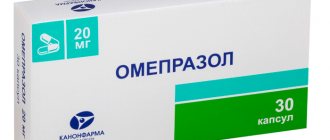Instructions
Choosing the right drug to treat gastritis and stomach ulcers can be difficult. For these diseases, drugs are used that are included in different pharmacological groups and have different effects on the functioning of the upper parts of the digestive system. The question often arises, which is better, Ultop or Omez. Evaluating the patient’s examination results and studying the characteristics of the drugs helps to choose a medicine.
Characteristics of Ultop
The medicine has the following characteristics:
- Release form. Ultop has the form of capsules in a dense shell, supplied in blisters or plastic cases.
- Compound. The active substance of the drug is omeprazole. The capsules also contain auxiliary components: magnesium carbonate, sugar, macrogol, talc, potato starch, gelatin, red iron oxide.
- Effect on the body. Omeprazole reduces the activity of enzymes secreted by parietal cells, inhibiting the final phase of hydrochloric acid production. This reduces the secretion of gastric juice, preventing the occurrence of ulcerative defects on the mucous membranes. The active component has a weak bactericidal effect on Helicobacter pylori.
- Scope of use. Ultop is used for gastroesophageal reflux, the presence of gastrinoma (a tumor that secretes large amounts of the hormone gastrin), peptic ulcer disease, and ulcer-like syndromes. For dyspepsia, the drug is used to prevent ulceration of the mucous membranes of the stomach and intestines.
- Side effects. Taking capsules may cause a feeling of heaviness in the stomach, nausea and vomiting, loose stools or constipation. The functions of the liver and hematopoietic system are less frequently impaired. With long-term treatment, patients may complain of headache, depression, and insomnia.
- Mode of application. Capsules are taken in quantities prescribed by a doctor, regardless of food intake. Exceeding the recommended dose leads to increased side effects.
"Omeprazole": brief information about the drug
Before moving on to a comparative analysis of these drugs, let's get to know each of them better.
First of all, it is worth clarifying that omeprazole is an active ingredient that is included in many drugs - both the same name “Omeprazole” and a number of its analogues.
The action of the substance omeprazole is aimed at reducing the acidity of the stomach. To do this, it acts both on the cells that produce hydrochloric acid, blocking their work, and on the gastric juice itself, neutralizing the acid. Against the background of its work, healing of ulcers, erosions and other damage to the mucous layer of the stomach walls occurs much faster and more successfully.
"Omeprazole" is often used by gastroenterologists in the treatment of diseases of the gastrointestinal tract, including the main indications for its use:
- Peptic ulcer in the stomach and duodenum;
- Reflux disease (including reflux exophagitis and GERD);
- Zollinger-Ellison syndrome;
The drug is taken orally once a day, it reaches maximum effectiveness approximately an hour after administration and is effective for another twenty-four hours. Since, most often, Omeprazole is prescribed as a course, during this time a certain amount of the drug accumulates in the body, which continues to act for several days after the end of treatment.
The liver is actively involved in the process of breaking down and removing Omeprazole from the body, so patients with liver disease are advised to use the medicine with caution.
Like almost all medicines, Omeprazole has a number of contraindications: allergies to the components of the drug, for patients under four years of age (under eighteen the drug is rarely prescribed and only in case of urgent need). Prescribing Omeprazole during pregnancy is possible if the benefits to the health of the mother outweigh the possible risks to the health of the fetus.
Characteristics of Omez
The antiulcer agent has the following characteristics:
- Dosage form and composition. The drug is available in the form of capsules in a transparent gelatin shell. The contents are represented by granules of white and cream colors. Each capsule contains 20 mg of omeprazole, milk sugar, mannitol, sodium hydrogen phosphate, sucrose, hypromellose.
- Pharmachologic effect. Omeprazole is a weak base. It accumulates in the acidic environment of the secretory cells of the gastric mucosa and blocks the membrane protein involved in the transfer of protons. Suppression of hydrochloric acid secretion is dose-dependent. The production of gastric juice when taking the drug is reduced regardless of food intake. With regular use, omeprazole stimulates the synthesis of protective mucus in the stomach. The drug eliminates pain and reduces the risk of developing ulcers.
- Indications for use. Omez is used in the treatment of erosive esophagitis, gastric ulcers, hyperacid gastritis, hypersecretory conditions (peptic erosions, Zollinger-Ellison syndrome, endocrine adenomatosis). In preparation for surgical interventions, the drug is taken to prevent aspiration pneumonitis.
- Side effects. Omez may interfere with digestion, causing nausea, vomiting and diarrhea. Allergic reactions, headaches, increased sweating, and kidney failure occur less frequently.
- Mode of application. The recommended single dose is 20 mg. Capsules are taken morning and evening, regardless of food intake. The duration of the therapeutic course is determined by the doctor.
Ultop
This is an antiulcer drug, its action is based on blocking the formation of hydrochloric acid, resulting in a decrease in the level of basal and stimulated secretion. Available in two-color capsules and ampoules (lyphilizate for solutions), the active ingredient is omeprazole. Excipients used:
- sodium lauryl sulfate;
- corn starch;
- sucrose;
- heavy magnesium carbonate;
- hyprolose;
- sugar granules.
After a single dose of the drug orally, it begins to act within an hour, after two hours it reaches its maximum effect, and the effect continues for a day. It takes 3 to 5 days for secretory activity to fully recover after stopping use.
Advantages
- release in various dosages (10, 20, 40 mg);
- can be used in the form of injections (in ampoules);
- high bioavailability in injection form;
- long half-life compared to analogues;
- effective in patients with impaired liver function;
- low cost in comparison with analogues.
Flaws
- many side effects;
- it takes a long time to reach maximum concentration.
Patient reviews
Elena
Since adolescence I have suffered from problems with the gastrointestinal tract, now in a chronic form. During this time, I took many medications, some helped better, others were ineffective. After I started taking Ultop, I am not looking for other medications. Quite satisfied: it works quickly, is highly effective, and inexpensive. I like. At work, it happens that people with ulcers come to me for a pill (if the medicine they are taking is not available). Relief comes from taking even one tablet. I'm sure this is a good indicator.
Galina
After FGS, erosion was discovered in the stomach, the doctor prescribed Ultop 20 mg to be taken morning and evening. I have been taking the medicine for 6 days, however, I forgot in the morning and took it in the evening. It grabbed me so much that I didn’t know where to go from the pain. Itching began, probably due to side effects.
Julia
I have high acidity, a friend recommended Ultop (she said that she has been taking it for a long time, eats everything and does not suffer from high acidity). After I took it the first time, everything was fine, but after 3 hours I began to feel discomfort in my stomach, then diarrhea. Then came vomiting, nausea and dizziness. The diarrhea continued throughout the second day and I could not eat. I do not advise anyone to take medicine without a doctor’s prescription! And check out the side effects.
Prevention and treatment of dysbiosis with folk remedies: the best recipes.
You can read the instructions for use of the drug Bifiliz in this article.
Comparison of Ultop and Omez
When comparing medications, both similarities and differences are revealed.
Similarities
Common features of Omez and Ultop include:
- the presence of the same active ingredient (omeprazole),
- impact on the human body,
- dosage form (both drugs are available in capsule form),
- pharmacokinetic parameters,
- scope of application,
- compatibility with antibiotics, making it possible to use drugs in the treatment of Helicobacter pylori infection.
Differences
The difference between the drugs lies in the presence of some excipients, the country of origin and contraindications. Unlike Ultop, Omez can be used to treat stomach diseases in children.
Which is cheaper?
The original drug Ultop has a higher price.
What's better?
It is quite difficult to understand which drug is more effective, since Omez and Ultop contain the same active substance. When choosing a medicine, cost becomes the determining factor. And in this case, generic drugs do not have pronounced advantages over each other.
Ultop or Nolpaza – which is better?
Nolpaza is an analogue of Ultop in tablets, produced by the same pharmaceutical company. It has an antiulcer, healing effect, reduces the secretion and negative effect of hydrochloric acid on the mucous membrane. Contains the active substance – pantoprazole.
Nolpaza and Ultop are identical in action, indications and limitations. Produced by one pharmaceutical company. They differ in the active substance - the first drug contains pantoprazole, the second omeprazole. It is advisable to replace Ultop with an analogue on the recommendation of a doctor, since it is available by prescription and has contraindications and side effects.
It is advisable for the patient to check with the attending physician what is best in each specific case. The effectiveness is influenced by the correct selection, the use of additional funds and compliance with recommendations, anamnesis, and features.
«>
Doctors' opinions and patient reviews
Maria, 43 years old, Moscow, gastroenterologist: “Both Omez and Ultop contain omeprazole, which gradually reduces the acidity of gastric juice. They help quickly cope with heartburn, stomach pain and digestive problems. These medications should only be taken as prescribed by a doctor. Otherwise, you can harm your body. When choosing a drug, you need to take into account the presence of auxiliary components that may be contraindicated in certain diseases.”
Victoria, 45 years old, Samara: “I used Ultop and Omez in the treatment of exacerbation of gastritis. Both drugs helped well, but I decided to go with a cheaper drug. The course of treatment helped get rid of stomach problems, which caused a lot of inconvenience. The medication was taken with adherence to the diet indicated for patients with gastritis. I felt relief after 3 days. The pain that comes with the feeling of hunger has stopped appearing. Completely got rid of heartburn and belching.”
Nina, 55 years old, Yakutsk: “I encountered gastritis as an adult. I worked a lot, so it took me a long time to get to the doctor. She took painkillers, but over time they stopped helping. The examination showed that gastritis turned into an ulcer. Several drugs were prescribed, including Ultop. After taking the capsules, I felt better, the burning pain in the chest disappeared, and chronic diarrhea stopped. There is also a cheaper analogue of Ultop - Omez, but the doctor did not advise taking it due to the high risk of side effects."
Ultop or Omeprazole: which is better, reviews of use, analogues of Ultop and Omeprazole
Nerves, haste, poor nutrition - these factors lead to the fact that the problems of gastritis and ulcers have become pressing for many. Therefore, it is so important to find the answer to the question: Ultop or Omeprazole - which is better? After all, it is these medications that lead the list of prescriptions for ulcer patients and those who suffer from gastrointestinal diseases. Which drug to buy - more expensive or cheaper?
Two names – one active ingredient?
In fact, this is true. How can you decide which medicine will be more effective - Ultop or Omeprazole? What is better and what is worse if they are created on the basis of the same component - omeprazole? The “scope of activity” of these drugs is also practically no different. They are proton pump inhibitors, used to treat erosive-inflammatory pathologies and gastric ulcers and act exclusively in the acidic environment inherent in the stomach. They come to the rescue if there is a malfunction in the normal functioning of the digestive system: the acidity of gastric secretions increases, its contents reflux into the esophagus, and ulcers appear on the mucous membrane.
Omeprazole and Ultop are analogues. They replace each other perfectly. You can make a choice between them, focusing only on the individual characteristics of the patient and the specifics of the course of the disease.
To form an unbiased opinion about which drug should be put in first place, it is best to study what is common between them, what are the differences, the pros and cons of each of these drugs. Let's do the analysis.
Comparative characteristics of Ultop and Omeprazole
If you have a dilemma about what to treat with - Omeprazole or Ultop, look at how they are similar:
- one active ingredient – omeprazole;
- release form - tablets (20 and 40 mg each);
- belong to antiulcer drugs that reduce the acidity of gastric juice and block the production of hydrochloric acid;
- eliminate heartburn, heal ulcers, reduce pain due to gastritis;
- have similar contraindications - intolerance to omeprazole, age under 18 years, pregnancy and lactation.
In fact, Ultop is Omeprazole. But, according to experts, there are still differences between them. Here they are:
- Various technologies are used in the manufacture of medicines. Ultop goes through more degrees of purification, so it produces less side effects;
- Ultop is manufactured in Slovenia, Omeprazole - in Russia (its production is carried out by Sintez OJSC);
- Indications for use vary slightly. For Ultop, this is dyspepsia of unknown etiology, prevention of ulcers; for Omeprazole – acute short-term heartburn, ulcers in the acute and chronic stages, impaired secretory function of the stomach;
- The list of additional components included in each of the drugs is also different. Ultop contains 6 such elements: sodium lauryl sulfate, sucrose, corn starch, magnesium carbonate, sugar granules, hyprolase. Omeprazole includes 4 auxiliary components: the same sodium lauryl sulfate, glycerin, tiana dioxide, gelatin;
- price. Ultop is much more expensive: it costs 104-270 rubles, while its Russian prototype (Omeprazole) will force the patient to shell out from 20 to 50 rubles. per packaging;
- Ultop has a specific contraindication - it is prohibited for those who suffer from sucrose intolerance.
Advantages and disadvantages of drugs: patient decision
It should be noted that both medications - Ultop and Omeprazole (reviews prove this), according to the patients themselves, are highly effective drugs. Among the advantages that are inherent in Ultop, they included the following qualities:
- It is also available in a small dosage - 10 mg;
- an injection form has been developed (for injections);
- it can be used by patients with liver pathologies;
- compared to other analogues, it has a relatively reasonable cost;
- acts quickly, the effect lasts up to 10 hours;
- even one tablet will relieve painful symptoms.
Is Ultop suitable as an emergency aid? Reviews say that it begins to act within an hour, and the maximum effect is detected after 2 hours.
Patients have noticed disadvantages of this medicine. The main ones are a large number of side effects; it takes a long time to reach maximum concentration.
What do they say about Omeprazole (by the way, its therapeutic “experience” is 37 years!)? Its advantages:
- has a convenient release form;
- acts quickly (1 hour after taking the tablet), the pain disappears completely after 2 hours;
- the pain syndrome is relieved within a day;
- reduces the likelihood of disease relapse.
People say that the downside is that when taking the drug, constipation is possible, food is less digestible, as the acidity of gastric juice decreases. There are adverse reactions, or the medicine does not help at all.
What do the doctor's say?
Experts do not give general recommendations about which drug is better.
They insist that the best medicine for each patient is selected based on medical history, symptoms and individual characteristics of the body.
But some doctors note that in 32% of cases, patients are found to be immune to the components of Omeprazole - thus, taking it does not provide any improvement.
Ultop and Omeprazole: analogues of these drugs
Today, the most famous drugs of a similar spectrum are Omez, Nexium, Pariet, Zhelkizol, Chrismel, Nolpaza, Ortanol, Zorsel, Omepruz, Romsek, Zerotsid, Omizak, Losek, Demeprazole, Helitsid, Gastrozol, Omefez, Cisagast.
What conclusion can be drawn based on brief drug monitoring? If we evaluate them from a financial point of view, then Omeprazole is much cheaper. As for side effects and effectiveness, Ultop looks more attractive.
It is less likely to cause unwanted effects and helps more patients. But the best decision about which will be better - Omeprazole or Ultop - will be made only by the attending physician based on the results of the examination and an accurate diagnosis.
Composition of the drug Ultop and its therapeutic effects
The drug Ultop is a gelatin capsule with enteric granules of the active substance omeprazole in different dosages and packaging:
- A cardboard pack containing 2-4 blisters containing 7 Ultop capsules with 10, 20, 40 mg of active substance;
- A cardboard box containing 1 polymer bottle containing 14 or 28 Ultop capsules with 10, 20, 40 mg of active substance.
In addition to the active substance omeprazole, each capsule also contains auxiliary ingredients:
- Sucrose;
- Corn starch;
- Talc;
- Sodium lauryl sulfate;
- Hydroxypropylcellulose;
- Magnesium carbonate is heavy;
- Methacrylate copolymer dispersion;
- Macrogol 6000;
- Titanium dioxide (E171);
- Gelatin;
- Iron oxide red (E172).
Ultop is also available in powder form for the preparation of a solution for injection. The cardboard package contains 1 ampoule with powder containing 40 mg of active substance.
The drug Ultop is prescribed to patients to reduce the production of gastric juice. The active substance included in its composition, entering the stomach, binds directly to enzymes produced by the cells of the stomach walls and reduces their activity.
Ultop capsules begin their full effect on the body within an hour after the first oral administration. This dynamic will last 70 hours. If the patient takes the drug repeatedly, its positive effect lasts up to 4 days. Relief of symptoms occurs immediately after the first dose.
Upon completion of therapy with the drug Ultop, its complete removal from the body will occur within 3-5 days. In patients suffering from liver failure, this process takes up to 7 days.











